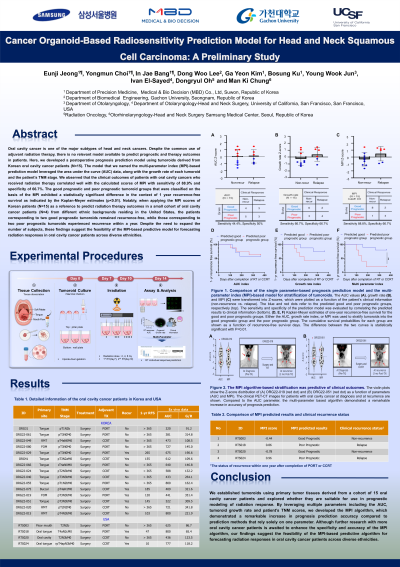Head and Neck Surgery
(0615) Cancer Organoid-Based Radiosensitivity Prediction Model for Head and Neck Squamous Cell Carcinoma: A Preliminary Study
Monday, September 30, 2024
12:00 PM - 1:00 PM EDT

Disclosure(s):
Man Ki Chung, MD: No relevant relationships to disclose.
Introduction: Predicting individual radiosensitivity is critical in determining treatment strategies for patients with head and neck squamous cell carcinoma (HNSCC). Here, we propose the cancer organoid-based platform for predicting individual radiotherapy (RT) response.
Methods: Head and neck cancer tissues were obtained from 21 patients who were planned to undergo RT. Tissues were dissociated into single cells and placed on a pillar plate to make the cancer organoids. After forming the organoids, these were exposed to 2, 4, and 8 Gy radiation doses in the lab. We stained live organoids with calcein AM after radiation and obtained organoid viability. AUC (area under curve), the growth rate, and the cancer stage score were combined to indicate the patient’s radiation sensitivity index, CODRP (Cancer Organoid-based Diagnosis Reactivity Prediction). The CODRP index was compared to the clinical outcomes of RT.
Results: As of the minimum follow-up of 12 months after the completion of RT, the laboratory-based radiosensitivity factors (CODRP) showed a sensitivity of 90.9% and a specificity of 80.9% to predict the clinical outcomes of RT. Also, in the CODRP model, the radiation-sensitive group showed an 11.2 % recurrence rate, while the radiation-resistant group showed an 83.4% recurrence rate. Moreover, there was a significant difference in recurrence-free survival rate between the sensitive and responder groups based on the CODRP model.
Conclusions: This study proposes a novel radiation sensitivity prediction model (Cancer Organoid-based Diagnosis Reactivity Prediction, CODRP) for head and neck cancer patients. CODRP models based on the patient's AUC, growth rate, and cancer stage successfully predict the clinical response to the RT.
- MC
Man Ki Chung, MD
Professor
Samsung medical center, Sungkyunkwan university School of medicine
Seoul, Seoul-t'ukpyolsi, Republic of Korea
